Abstract
The expression of aromatase was evaluated in 38 breast carcinomas by an immunohistochemical method (ABC) using an specific polyclonal antibody against human placental aromatase. Fifteen tumors (40%) showed significant immunoreactivity, as defined by cytoplasmic positivity of moderate intensity present in at least 15% of the cells. The results were correlated with the estrogen and progesterone hormone receptor status and several clinicopathologic parameters such as age, tumor size, lymph node status, and stage of the disease. There was a significant, but inverse, correlation between the aromatase activity and the estrogen receptor status (P = 0.04), indicating the likelihood of negative estrogen if substantial aromatase activity was present. No statistically significant correlation was found between the presence of intratumoral aromatase and the rest of the parameters studied (P greater than 0.7). Nor was there a correlation between the aromatase content of the tumors and the menopausal status. The degree of intratumoral heterogeneity of the aromatase content was minimal in six cases where multiple samples from each tumor were analyzed. This is the first study reporting the detection of aromatase in archival material from breast carcinomas using immunohistochemical techniques. The lack of biologic significance of its presence in breast cancer reported here and by others using biochemical assays should be validated in larger series with longer follow-up. The method described can be readily used for that objective.
Full text
PDF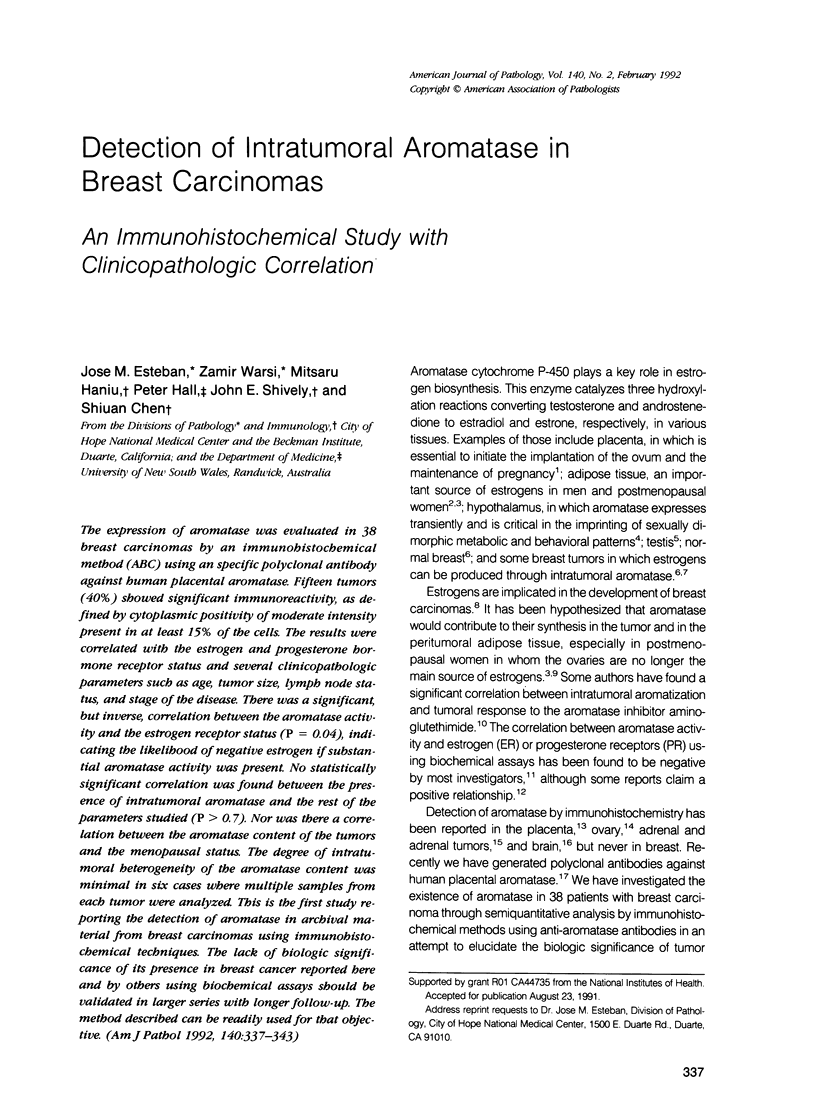
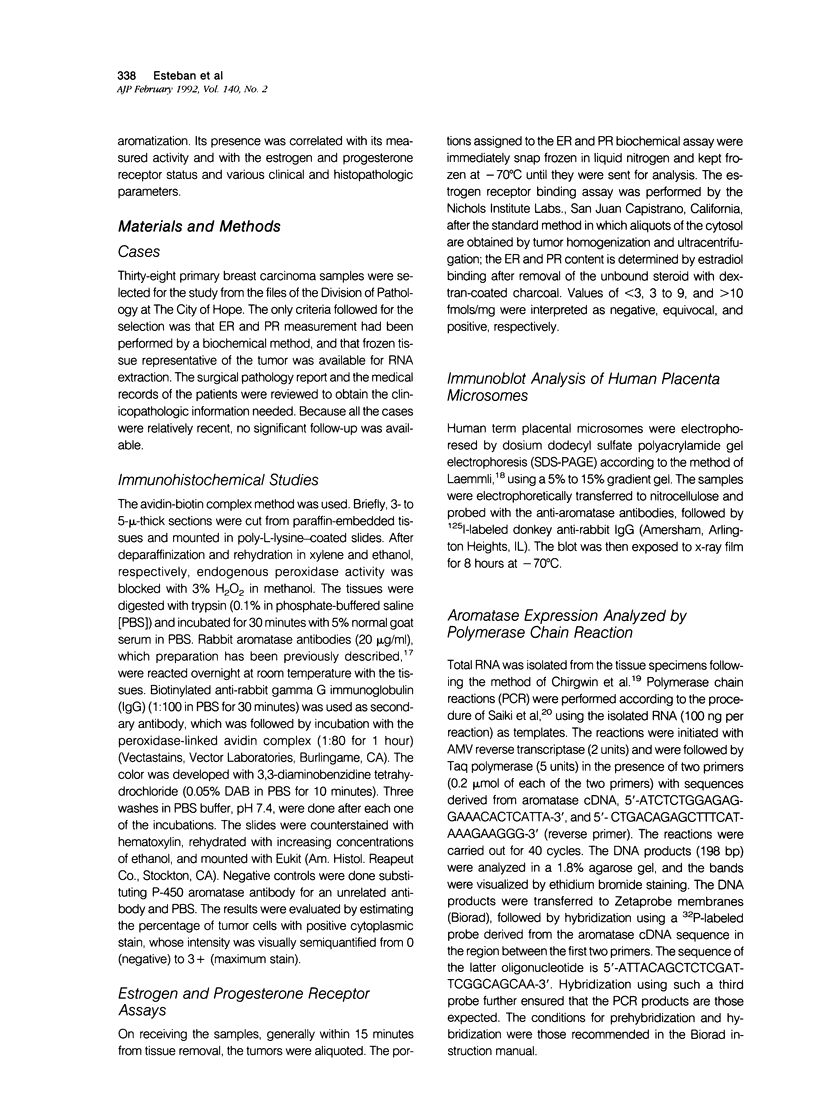
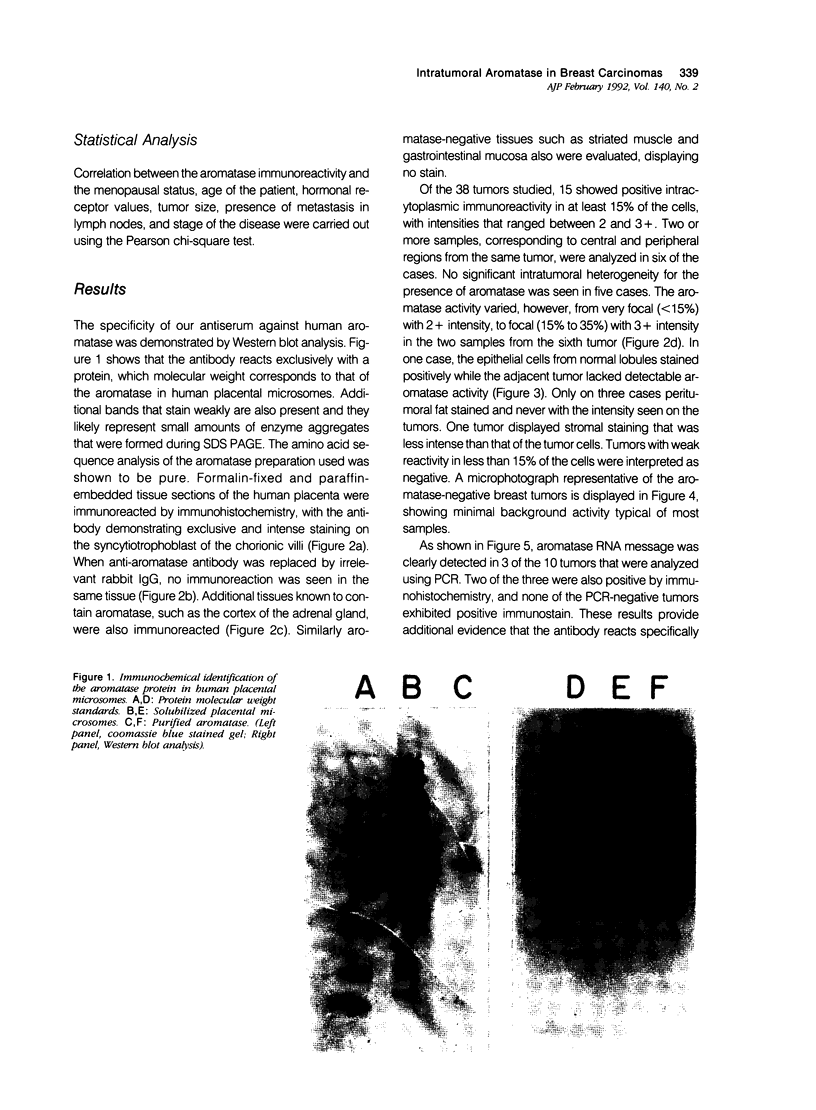
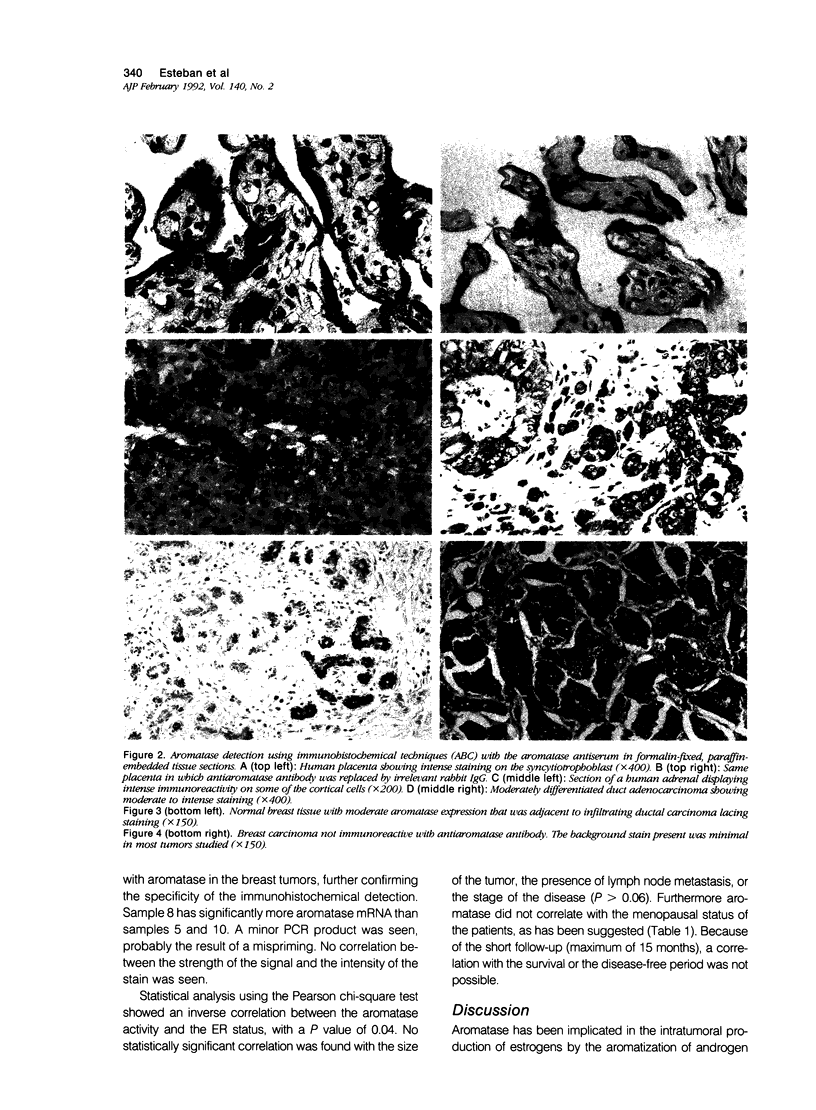
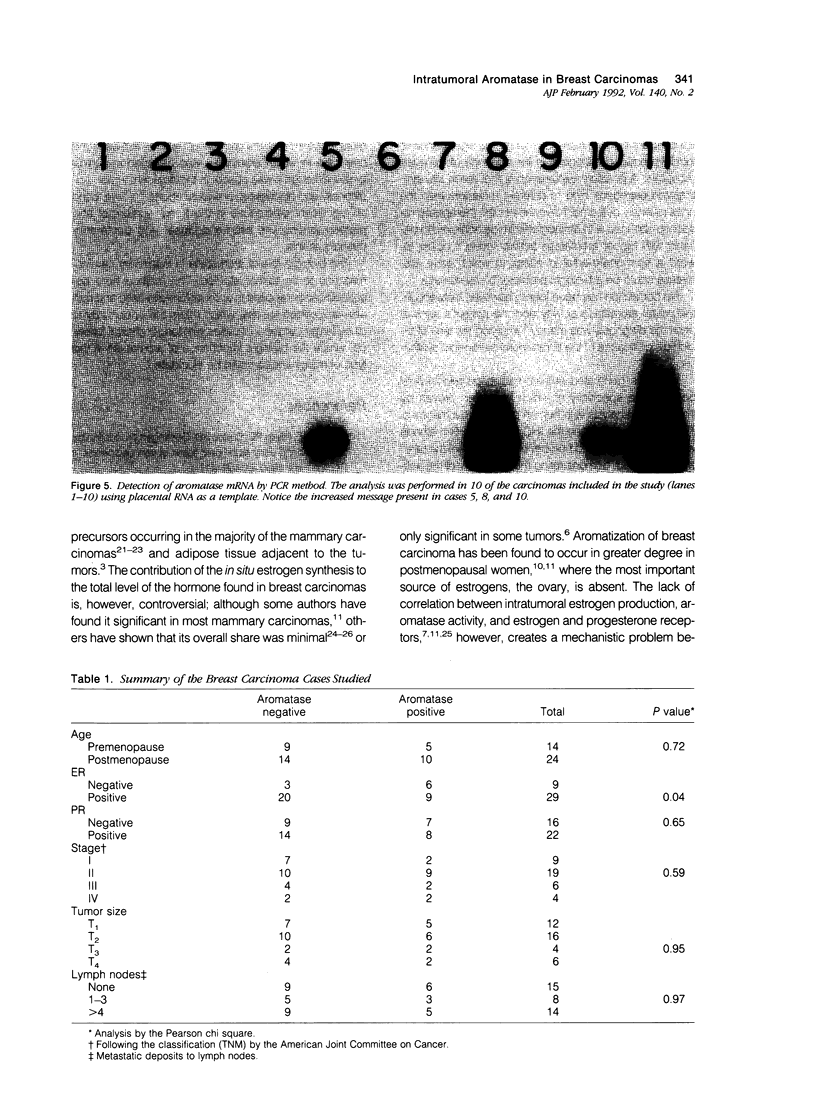
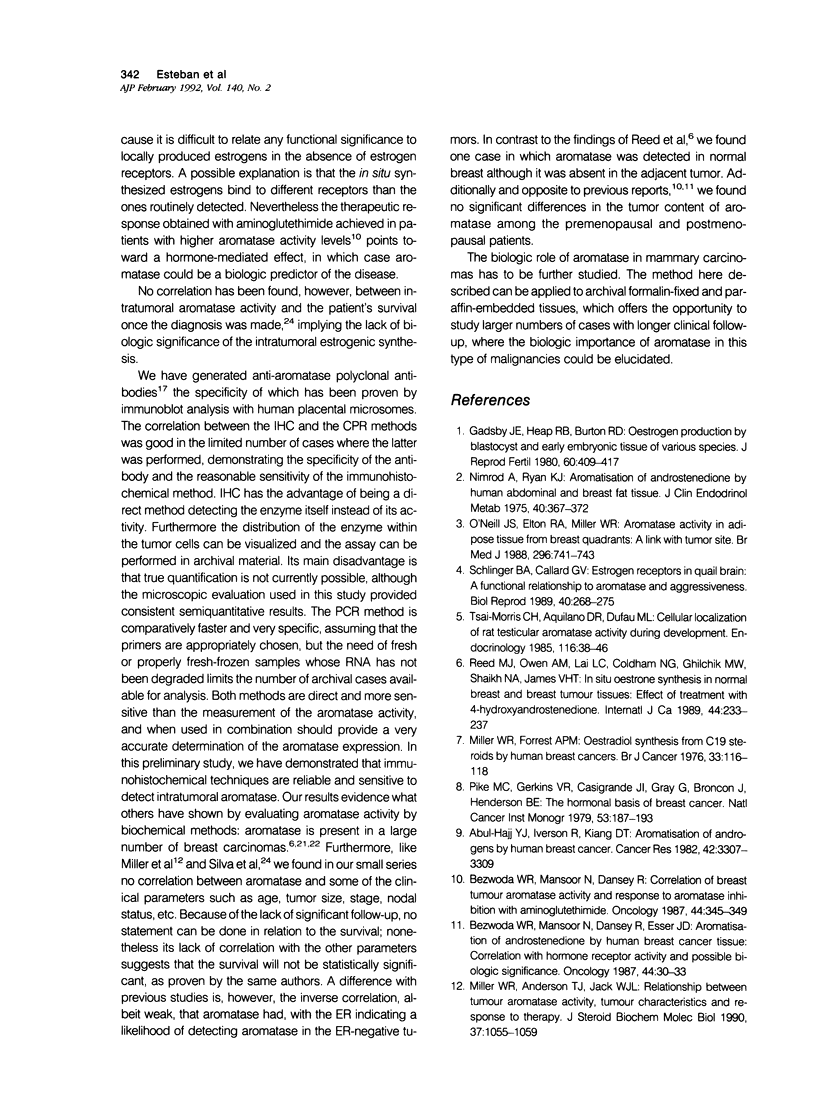

Images in this article
Selected References
These references are in PubMed. This may not be the complete list of references from this article.
- Bezwoda W. R., Mansoor N., Dansey R. Correlation of breast tumour aromatase activity and response to aromatase inhibition with aminoglutethimide. Oncology. 1987;44(6):345–349. doi: 10.1159/000226509. [DOI] [PubMed] [Google Scholar]
- Bezwoda W. R., Mansoor N., Dansey R., Esser J. D. Aromatisation of androstenedione by human breast cancer tissue: correlation with hormone receptor activity and possible biologic significance. Oncology. 1987;44(1):30–33. doi: 10.1159/000226438. [DOI] [PubMed] [Google Scholar]
- Chirgwin J. M., Przybyla A. E., MacDonald R. J., Rutter W. J. Isolation of biologically active ribonucleic acid from sources enriched in ribonuclease. Biochemistry. 1979 Nov 27;18(24):5294–5299. doi: 10.1021/bi00591a005. [DOI] [PubMed] [Google Scholar]
- Fournet-Dulguerov N., MacLusky N. J., Leranth C. Z., Todd R., Mendelson C. R., Simpson E. R., Naftolin F. Immunohistochemical localization of aromatase cytochrome P-450 and estradiol dehydrogenase in the syncytiotrophoblast of the human placenta. J Clin Endocrinol Metab. 1987 Oct;65(4):757–764. doi: 10.1210/jcem-65-4-757. [DOI] [PubMed] [Google Scholar]
- Gadsby J. E., Heap R. B., Burton R. D. Oestrogen production by blastocyst and early embryonic tissue of various species. J Reprod Fertil. 1980 Nov;60(2):409–417. doi: 10.1530/jrf.0.0600409. [DOI] [PubMed] [Google Scholar]
- Laemmli U. K. Cleavage of structural proteins during the assembly of the head of bacteriophage T4. Nature. 1970 Aug 15;227(5259):680–685. doi: 10.1038/227680a0. [DOI] [PubMed] [Google Scholar]
- Li K., Adams J. B. Aromatization of testosterone and oestrogen receptor levels in human breast cancer. J Steroid Biochem. 1981 Mar;14(3):269–272. doi: 10.1016/0022-4731(81)90135-7. [DOI] [PubMed] [Google Scholar]
- Lipton A., Santner S. J., Santen R. J., Harvey H. A., Feil P. D., White-Hershey D., Bartholomew M. J., Antle C. E. Aromatase activity in primary and metastatic human breast cancer. Cancer. 1987 Feb 15;59(4):779–782. doi: 10.1002/1097-0142(19870215)59:4<779::aid-cncr2820590419>3.0.co;2-u. [DOI] [PubMed] [Google Scholar]
- McKenna T. J., O'Connell Y., Cunningham S., McCabe M., Culliton M. Steroidogenesis in an estrogen-producing adrenal tumor in a young woman: comparison with steroid profiles associated with cortisol- and androgen-producing tumors. J Clin Endocrinol Metab. 1990 Jan;70(1):28–34. doi: 10.1210/jcem-70-1-28. [DOI] [PubMed] [Google Scholar]
- Miller W. R., Anderson T. J., Jack W. J. Relationship between tumour aromatase activity, tumour characteristics and response to therapy. J Steroid Biochem Mol Biol. 1990 Dec 20;37(6):1055–1059. doi: 10.1016/0960-0760(90)90465-w. [DOI] [PubMed] [Google Scholar]
- Miller W. R., Forrest A. P. Oestradiol synthesis from C19 steroids by human breast cancers. Br J Cancer. 1976 Jan;33(1):116–118. doi: 10.1038/bjc.1976.13. [DOI] [PMC free article] [PubMed] [Google Scholar]
- Miller W. R., O'Neill J. The importance of local synthesis of estrogen within the breast. Steroids. 1987 Oct-Dec;50(4-6):537–548. doi: 10.1016/0039-128x(87)90037-7. [DOI] [PubMed] [Google Scholar]
- Nakajin S., Shinoda M., Hall P. F. Purification to homogeneity of aromatase from human placenta. Biochem Biophys Res Commun. 1986 Jan 29;134(2):704–710. doi: 10.1016/s0006-291x(86)80477-6. [DOI] [PubMed] [Google Scholar]
- Nimrod A., Ryan K. J. Aromatization of androgens by human abdominal and breast fat tissue. J Clin Endocrinol Metab. 1975 Mar;40(3):367–372. doi: 10.1210/jcem-40-3-367. [DOI] [PubMed] [Google Scholar]
- O'Neill J. S., Elton R. A., Miller W. R. Aromatase activity in adipose tissue from breast quadrants: a link with tumour site. Br Med J (Clin Res Ed) 1988 Mar 12;296(6624):741–743. doi: 10.1136/bmj.296.6624.741. [DOI] [PMC free article] [PubMed] [Google Scholar]
- Pike M. C., Gerkins V. R., Casagrande J. T., Gray G. E., Brown J., Henderson B. E. The hormonal basis of breast cancer. Natl Cancer Inst Monogr. 1979 Nov;(53):187–193. [PubMed] [Google Scholar]
- Reed M. J., Owen A. M., Lai L. C., Coldham N. G., Ghilchik M. W., Shaikh N. A., James V. H. In situ oestrone synthesis in normal breast and breast tumour tissues: effect of treatment with 4-hydroxyandrostenedione. Int J Cancer. 1989 Aug 15;44(2):233–237. doi: 10.1002/ijc.2910440208. [DOI] [PubMed] [Google Scholar]
- Saiki R. K., Gelfand D. H., Stoffel S., Scharf S. J., Higuchi R., Horn G. T., Mullis K. B., Erlich H. A. Primer-directed enzymatic amplification of DNA with a thermostable DNA polymerase. Science. 1988 Jan 29;239(4839):487–491. doi: 10.1126/science.2448875. [DOI] [PubMed] [Google Scholar]
- Sasano H., Okamoto M., Mason J. I., Simpson E. R., Mendelson C. R., Sasano N., Silverberg S. G. Immunohistochemical studies of steroidogenic enzymes (aromatase, 17 alpha-hydroxylase and cholesterol side-chain cleavage cytochromes P-450) in sex cord-stromal tumors of the ovary. Hum Pathol. 1989 May;20(5):452–457. doi: 10.1016/0046-8177(89)90010-5. [DOI] [PubMed] [Google Scholar]
- Schlinger B. A., Callard G. V. Estrogen receptors in quail brain: a functional relationship to aromatase and aggressiveness. Biol Reprod. 1989 Feb;40(2):268–275. doi: 10.1095/biolreprod40.2.268. [DOI] [PubMed] [Google Scholar]
- Shinoda K., Yagi H., Fujita H., Osawa Y., Shiotani Y. Screening of aromatase-containing neurons in rat forebrain: an immunohistochemical study with antibody against human placental antigen X-P2 (hPAX-P2). J Comp Neurol. 1989 Dec 22;290(4):502–515. doi: 10.1002/cne.902900405. [DOI] [PubMed] [Google Scholar]
- Silva M. C., Rowlands M. G., Dowsett M., Gusterson B., McKinna J. A., Fryatt I., Coombes R. C. Intratumoral aromatase as a prognostic factor in human breast carcinoma. Cancer Res. 1989 May 15;49(10):2588–2591. [PubMed] [Google Scholar]
- Tsai-Morris C. H., Aquilano D. R., Dufau M. L. Cellular localization of rat testicular aromatase activity during development. Endocrinology. 1985 Jan;116(1):38–46. doi: 10.1210/endo-116-1-38. [DOI] [PubMed] [Google Scholar]







